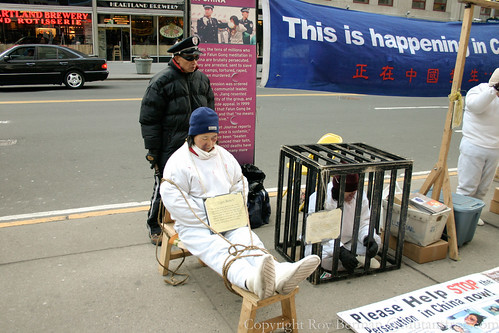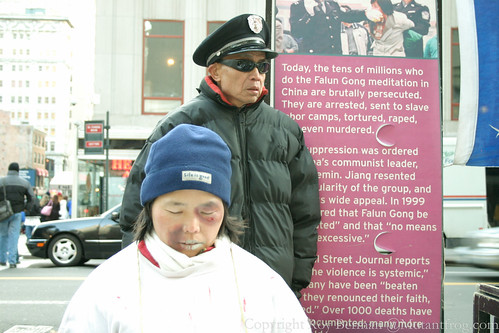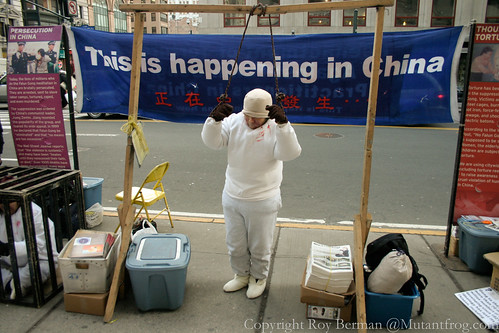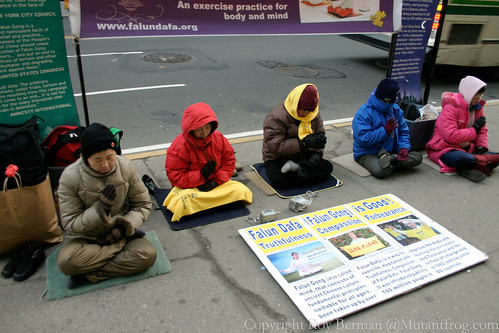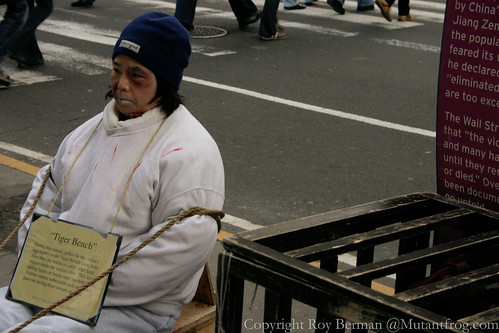I spent the new year holiday seeing the sights in Guangdong and Hong Kong. Probably the most interesting sights came from the 2-hour train ride from Guangzhou to Kowloon.
Category: China
Falun Gong theatre in New York
The NYT has a rather funny article about New Yorkers who attended what they thought would be a traditional Chinese New Year theatrical spectacle at the Radio City Music Hall, but ended up seeing a very different kind of show.
Then the lyrics to some of the songs, sung in Chinese but translated into English in the program, began referring to “persecution” and “oppression.” Each time, almost at the moment a vocalist hit these words, a few audience members collected their belongings and trudged up an aisle toward the exit.
Before long came a ballet piece in which three women were imprisoned by a group of officers, and one was killed. At the end of the number, more members of the audience, in twos and fours and larger groups, began to walk out. At intermission, dozens of people, perhaps a few hundred, were leaving.
They had realized that the show was not simply a celebration of the Chinese New Year, but an outreach of Falun Gong, a spiritual practice of calisthenics and meditation that is banned in China. More than three years after flooding city corners and subway stations to spread the word about the Chinese government’s repression, Falun Gong practitioners are again trying to publicize their cause. Only this time, it involves costumed dancers and paying audiences in that most storied of New York concert halls, Radio City.
The article then goes on to mention that Faul Gong is well known for their elaborate street theatre protests around the city, in which they use props and stage makeup to dramatize the torture their compatriots are undergoing in China, as they hand out literature on the subject. Here are some photos I took of one such protest back in May of 2005.
Has anyone ever seen something like this anywhere besides New York? I saw Falun Gong protesters in Hong Kong, by Victoria Bay, and handing out flyers and DVDs outside of Taipei’s National Palace Museum (prime location to find tourists from the mainland) but never anything like this sort of dramatic reenactment.
I still think they taste like cardboard
Everyone reading this is familiar with the tasteless paper-filled, paper-textured fortune cookie right? Long thought to have originated as a gimmick desert in one of California’s Chinatowns sometimes in the late 19th or early 20th century, new research strongly suggests that, despite being popularized by the Chinese, fortune cookies were actually invented by Japanese immigrants, who had gotten their inspiration from snacks sold at a Kyoto bakery. The New York Times has an excellent article detailing the whole story, which I must say I find surprisingly convincing. I think anyone else familiar with the wide range of tasteless Japanese traditional snacks (八ッ橋 anyone ? ), the Japanese love for fortunes, and of the tasteless fortune-filled “fortune cookies” distributed inevitably in American Chinese restaurants will also, upon reflection, find the resemblance highly suggestive.
Plastic bags of doom
It looks like fresh attention is being paid to the fact that plastic bags are among the most troublesome and pernicious forms of waste. How bad? Well, “continents of floating garbage” for a start. Think that’s an exaggeration? Well, “One plastic patch is estimated to weigh over 3 million tons and covers an area twice the size of Texas.” And how much ecological damage does it do?
The United Nations Environment Program says plastic is accountable for the deaths of more than a million seabirds and more than 100,000 marine mammals such as whales, dolphins and seals every year.

That almost certainly dwarfs any damage to cetacean populations that could be caused by, to take a far more famous issue, Japan’s “scientific” whaling program. Not to mention the yet-unknown effects that all of this plastic is likely having on fish, algae, plankton, etc. Could the collapsing fishing stocks be attributable not just to the direct action of over-fishing, but also to poisoning and choking by gargantuan amounts of plastic?
Since the plastic tends to gather in isolated and rarely trafficked patches of sea, so deep into international waters that no country even crosses path with it, much less has responsibility for it. As yet, there is no world body with either the political motivation, technology, or infrastructure necessary for embarking on what would easily be the largest cleanup project in history, and it is difficult to imagine any realistic way that such a huge mass could be removed.
Still, as hopeless as the cleanup is, at least the world is beginning to work to phase out the manufacture and use of such plastic bag, which will at least slow down the rate at which the problem worsens. An announcement earlier today that China-the world’s largest and most polluting nation-will be drastically cutting plastic bag usage is an important step.
As in most countries that have attempted to tackle the problems causes by plastic bag waste, China will primarily be relying not on a total ban on their use, but a requirement that stores no longer give them out free with purchases, but charge extra for them. It is hoped that imposing a surcharge on the bags will encourage customers to bring their own environmentally friendly reusable bags when they go shopping, as has been the case in other countries.
While, as far as I know, Bangladesh is the only country which has as yet completely banned the distribution of plastic bags, a number of countries have imposed bag surcharges similar to the one proposed for China. Taiwan introduced a charge equivalent to something like 5-7 US cents per bag, Singapore has a similar system, and Ireland-an island about twice the size of Taiwan, and formerly a consumer of over 1.2 BILLION plastic bags per year-has imposed a 15 cents/bag fee that is credited with reducing their use by 90%. Other countries in Europe, most likely starting with Ireland’s next-door neighbor of Britain, will likely follow.
Some other countries, such as Japan, have been relying on voluntary conservation to combat plastic bag proliferation. Although some Japanese supermarkets have taken the bold step of simply not having bags at all, they are still given away for free in most businesses. However, convenience stores recently began offering a discount of several yen to customers who refuse a plastic bag. Although the clerk is officially supposed to ask customers if they need a bag, in my experience they almost never do, and simply give them out habitually.
Although I have yet to hear a serious proposal to either ban or charge for plastic bags in the heavy consuming United States, I have recently noticed two well-meant but minor initiatives. The first was at the New York University campus bookstore and computer stores, where if you refuse a plastic bag they give you a token you throw into one of four or five bins near the exit, each one representing a charity. Each token pledges a 5 cents donation to that charity. The other was a sign at my local A&P Supermarket, promising a discount of a few cents for customers who bring their own bags. Unfortunately, this will certainly prove as ineffectual as the convenience store initiative in Japan, particularly since I only saw the sign by the exit, in an area not even visible from the cash register/bagging area.
Will these various measures have a major effect on the plastic bag problem? The answer to that thankfully seems to be a yes-but a qualified yes. It is still to early to know how much ecological damage the vast amounts of plastic already in the ocean have caused, or will cause in the future. And despite movement towards curbing the future growth of the “continents of floating garbage,” we may never be able to get rid of them.
For more information on the oceanic plastics quandary, have a look at this short documentary, filmed on location in the Pacific Ocean.
A bit more on KMT remnant in SE Asia
I was pretty surprised and fascinated by a BBC mention last week of KMT soldiers who had fled to Southeast Asia instead of Taiwan, and turned to banditry and drug trafficking instead of soldiery. In an excellent coincidence, the Taipei Times ran an article on Saturday’s issue on just this subject.
Descendants of KMT soldiers living in limbo
ON THE MARGINS: The offspring of former KMT soldiers who fled China are finding that while they are welcome to study in Taiwan, they may not be able to reside here
By Loa Iok-sin
STAFF REPORTER
Saturday, Nov 03, 2007, Page 2 “Stateless” descendants of former Chinese Nationalist Party (KMT) troops stationed in northern Myanmar and Thailand yesterday pleaded with the government to naturalize them.Tens of thousands of KMT troops retreated across the Chinese border and stationed themselves in northern Myanmar and Thailand following the defeat of Chiang Kai-shek’s (蔣介石) Nationalist forces by the Communists in the Chinese Civil War.
As the push to retake China never took place, many of the soldiers and their families were stranded in the region.
Since these people entered Myanmar and Thailand illegally, they are not recognized by the two countries. Their descendants have thus been denied citizenship, although many of them were born and raised in these countries.
Some of these stateless people faced a new challenge after coming to Taiwan to attend college.
Chen Chai-yi (
陳彩怡 ), from northern Myanmar, told her story during a press conference held at the legislature yesterday.“I passed the college entrance exam held by Taiwan’s Overseas Compatriot Affairs Commission [OCAC] and was accepted by a university in Taiwan in 2003,” Chen said.
However, since she had no citizenship from either country, Chen purchased a forged Burmese passport to travel with, she said.
It was only once Chen arrived in the country that she discovered she would be required to prove her status before receiving Taiwanese citizenship.
“I wasn’t aware of this and the OCAC didn’t tell me when I took the exam [in Myanmar],” Chen said.
“I cannot return to Myanmar because I will be imprisoned for life for holding a forged passport, but my stay in Taiwan will also become illegal once I graduate from college,” Chen said. “I’m basically stuck.”
Liu Hsiao-hua (劉小華), chief executive of the Thai-Myanmar Region Chinese Offspring Refugee Service Association, estimated that more than 1,000 students from the region are in a similar situation.
Lee Lin-feng (
李臨鳳 ), an Immigration Bureau official, said that there are difficulties involved in granting these people citizenship.“What has blocked these people from obtaining Taiwanese citizenship is that neither they nor the Ministry of National Defense have any proof that they are descendants of former soldiers,” Lee said. “Even when some had proof, they were unable to submit a certificate renouncing their original nationality.”
Lee said she would seek a solution at the next Ministry of the Interior meeting, “considering the special circumstances.”
I’m rather surprised that these former KMT soldiers and their descendants have remained stateless for so long. It is hardly expected that Burma or Thailand would have granted them citizenship. Although both countries do have communities of Chinese citizens, they would hardly have put escaping soldiers and criminals in the same category as immigrant merchants. The article does explain that “these people [do not] have any proof that they are descendants of former soldiers,” but I have yet to see any reason for why the KMT remnant in SE Asia never rejoined their main force on Taiwan, once it was clear that they were well established there, and the threat of invasion from the mainland began to recede.
The article mentions the Overseas Compatriot Affairs Commission [OCAC] (see their official English language website here,) which handles documentation and residency for overseas Chinese citizens (Overseas Compatriot.) While in a strict technical sense, Republic Of China citizenship theoretically extends to all of China, as the ROC is constitutionally the government of China, but as the ROC itself has shrunk to include what may someday be called merely the Republic Of Taiwan, ROC citizenship today more or less means Taiwanese citizenship, and in practice excludes any citizen of the People’s Republic of China.
While I do not have time at the moment to examine it in detail, the OCAC provides rules on Overseas Compatriot status, as well as rules for applying to study in Taiwan through the OCAC, using the process referred to in the above article.
Another mention of the KMT remnant turned criminal in SE Asia comes from a surprising source- the subject of the new Denzel Washington film American Gangster, the famous real-life New York based drug dealer Frank Lucas. The following text is from an interview article in New York Magazine:
Lucas soon located his main overseas connection, an English-speaking, Rolls-Royce-driving Chinese gentleman who went by the sobriquet 007. “I called him 007 because he was a fucking Chinese James Bond.” Double-oh Seven took Lucas upcountry, to the Golden Triangle, the heavily jungled, poppy-growing area where Thailand, Burma, and Laos come together.
“It wasn’t too bad, getting up there,” says Lucas. “We was in trucks, in boats. I might have been on every damn river in the Golden Triangle. When we got up there, you couldn’t believe it. They’ve got fields the size of Tucson, Arizona, with nothing but poppy seeds in them. There’s caves in the mountains so big you could set this building in them, which is where they do the processing . . . I’d sit there, watch these Chinese paramilitary guys come out of the mist on the green hills. When they saw me, they stopped dead. They’d never seen a black man before.”
Likely dealing with remnants of Chiang Kai-shek’s defeated Kuomintang army, Lucas purchased 132 kilos that first trip. At $4,200 per unit, compared with the $50,000 that Mafia dealers charged Stateside competitors, it would turn out to be an unbelievable bonanza. But the journey was not without problems.
“Right off, guys were stepping on little green snakes, dying on the spot. Then guess what happened? Banditos! Those motherfuckers came right out of the trees. Trying to steal our shit. The guys I was with — 007’s guys — all of them was Bruce Lees. Those sonofabitches were good. They fought like hell.
“I was stuck under a log firing my piece. Guys were dropping. You see a lot of dead shit in there, man, like a month and a half of nightmares. I think I ate a damn dog. I was in bad shape, crazy with fever. Then people were talking about tigers. I figured, that does it. I’m gonna be ripped up by a tiger in this damn jungle. What a fucking epitaph . . . But we got back alive. Lost half my dope, but I was still alive.”
(Via the Fighting 44s blog, pointed out by my friend Jon Lung.)
Tangential end-note: searching for “military remnant” on Google produced an article on the remnant of the Galactic Empire in Star Wars, following the end of Return of the Jedi.
More skeletons in the KMT closet
Just when I think I have a fairly good idea about what the Chinese Nationalist Party, aka Kuomintang (KMT) has been up to over the years, I read the following text in a BBC obituary of Burmese warlord, gangster, opium smuggler and “prince of death” Khun Su.
Born in 1933 to a Chinese father and a mother from Burma’s Shan ethnic group, Khun Su’s given name was Chan Chi-fu.
Growing up in the Burmese countryside, he had little education and came of age fighting Chinese nationalist Kuomintang (KMT) soldiers, who had been forced out of China by the Communists.
The KMT rapidly took over and expanded the opium trade in the region, but Chan Chi-fu and his gang gradually began to exert their influence during the 1960s.
Allied with the Burmese government, they are thought to have fought against both the KMT and the Shan nationalists in exchange for being allowed to continue trading opium.
All of us here know that the KMT as an organization, following their defeat by the CCP in the Chinese civil war, fled to Taiwan where they ruled a one-party police state for decades, and that many of them had been engaged in warlordism and banditry on the Chinese mainland before and during the civil war (this corruption was one factor in their defeat,) but I do not recall reading before about KMT members who fled to and engaged in banditry in SE Asia in large numbers. I do, however, find it a little amusing that Khun Su would, with his history of fighting the KMT, “play host to journalists and Western tourists, treating them to Taiwanese pop music.” After fighting KMT bandits in Burma, mightn’t be be a little bit sour towards Taiwan?
Anyway, do any readers have any suggestions for sources to look at on similar KMT banditry/criminal activity in SE Asia, following their flight to Taiwan?
Link clearage time
As often happens, I have a pile of interesting pieces that I meant to save, which have just been sitting in my open tabs, so time for a brief roundup.
- Howard French of the New York Times has an article on how Tibetans protest Chinese commodification and colonization of their culture through nonviolent protest, such as lack of participation in PRC-sponsored festivals that are claimed by the Chinese MC to be “[their] very own Khampa Festiva,” and observance of the exiled Dalai Lama’s recent ban on the wearing of endangered animal skins.
- Asahi reports that an announcer on North Korean state television may actually be a Japanese citizen abducted in 1988. I am unclear from the article whether he is announcing in that amusingly over the top militaristic enunciation that DPRK television announcers seem to be trained in.
- The Japan Aerospace Exploration Agency (JAXA) has rescheduled the launch of their Selenological and Engineering Explorer (SELENE) for September 13, 10:35 JST, the largest Lunar exploration mission since Apollo. Although it is unfortunately not a manned mission, having three satellites in orbit around the moon bodes well for the future, as far as I’m concerned.
- A recent survey (admittedly sponsored by Taiwanese interests) shows that Taiwanese are “model immigrants” to the USA. This follows on the heals of Taiwan’s entry to the shortlist of countries being considered for 2008 expansion of the USA visa waiver program based on such factors, determined by US government studies, extremely low rates of visa rejection and visa overstaying, which may bolster chances for Taiwanese (ROC) citizens to gain visa-free temporary entry into the US, much as they were recently given visa-free entry rights to Japan in September of 2005.
- In related news, Japan is expected to amend their traffic regulations to accept Taiwanese drivers licenses as valid in Japan, starting on September 19. This will add Taiwan to the short list of countries whose licenses are considered valid in Japan-a list which notably does NOT include the United States.
- The NYT had a very interesting article (unfortunately it’s already entered the subscriber-only sections, so most readers may not have access) on July 31 on the past and future of language in East Timor. The gist of it is that Portuguese, formerly the official language of the country when it was a Portuguese colony but which was later banned by Indonesia after they annexed it in 1975, is now once more the official language of courts, schools and government. Although Tetum, the most common language, and Indonesian, the language of their larger neighbor which was also official in East Timor during the period of Indonesian rule, are both vastly more widely recognized than Portuguese, but Tetum is considered unsuitable for government business and modern education due to a lack of a sophisticated technical vocabulary, and Indonesian likewise considered unsuitable due to the general resentment of decolonization. Portuguese, despite itself being a former colonial language, is apparently fondly regarded by the older generation, and has also left a serious impact on the vocabulary of native languages, and presumably also left behind a large body of legal texts and other literature dating back to the period of Portuguese rule.
I find this an interesting case for comparison with Taiwan, where the Japanese language forced upon the Taiwanese population during their 50-year span of colonization by Japan was also looked back with some degree of sentimentality-along with Japanese rule itself-following the island’s subsequent “colonization” by the Chinese Nationalist government of the Republic of China. Although Japanese has never become an official language of ROC/Taiwan and has also never regained widespread usage, based on this article it does seem to occupy a psychic space similar to that of Portuguese in East Timor.
- Very cool article, also originally from the NYT, but reposted on the Taipei Times website (thankfully avoiding the NYT’s lame archival process) on the prevalence of foreign languages and translation in the New York City public school system. Here’s the meat of the article:
Forty-two percent of the parents of children in the school system, the country’s largest, are not native English speakers, and communicating with them about their children’s education is an immense challenge.
That is especially the case at a time when the system is offering ever-increasing school choices, but is also requiring students to go through a complex admissions process for high school and certain programs.
So, prodded by advocates for immigrants, schools chancellor Joel Klein created a unit three years ago to translate a never-ending flow of school documents, like news releases, report cards and parent surveys, into the eight languages most commonly spoken in New York, after English: Spanish, Chinese, Russian, Bengali, Arabic, Urdu, Korean and Haitian Creole.
It has since expanded to an office with 40 employees and a US$4.5 million budget, and is the largest of its kind in any school system in the US, said Kleber Palma, the unit’s director. In one respect, the office even surpasses the translation division at UN headquarters, which translates most documents into only five official languages other than English: Arabic, Chinese, French, Russian and Spanish.
- ESWN brings us more news on Harry Potter in China. University and Secondary Students Were The Main Forces in Citizen Translations of Harry Potter Book 7.
- The NYT has also posted publisher’s summaries and a few brief excerpts of eight fake Harry Potter sequels published in China. They do have Harry Potter and the Big Funnel (better known as Harry Potter and The Filler of Big), but seem to have missed Harry Potter and Beaker and Burn. Amusingly, just before this was published I was contacted by a prominent American monthly magazine (who shall remain nameless), asking me for assistance in obtaining copies of the same Harry Potter books for a similar translation feature. I put in about three hours of effort before the NYT published this feature, and the magazine canceled their plans. But don’t worry, they’re still paying me for my time, and even sent me some entirely unrelated Japan-related research work.
Today’s bad news
The Chinese Baiji river dolphin may be extinct, but if any survivors are eventually found, at least they can safely be relocated to the tunnels used by the New York City subway until this morning.
Seikaryo
Readers who remember my discussions of Kokaryo(光華寮), the Kyoto student dormitory for overseas Chinese students which became the center of the longest duration lawsuit in Japanese legal history might be interested to know about Seikaryo (清華寮), a Chinese student dormitory located in Tokyo, which was purchased under significantly different, but also interesting circumstances.Seikaryo recently made the news due to a tragic fire that killed two women living there, which was brought to my attention via an email from Curzon. Seikaryo, like Kokaryo, was originally purchased as a dormitory for Taiwanese students studying in Japan, but where Kokaryo had been purchased by the Taiwanese Republic of China government (possible with funds that may have been repayment for property taken by Japan from mainland China-this and other vagaries led to the bizarre and complex circumstances of the lawsuit, about which one can read in my earlier pieces), Seikaryo was constructed in 1927 by a foundation belonging to the Japanese colonial Governor General in Taiwan, when Taiwan was an internationally recognized colonial possession of Japan.
According to this article, the property rights of the dormitory were unclear after the war, leading to problems involving such things as the assessment of taxes, but apparently-unlike Kokaryo- it remained a residence for students from both Taiwan and China. This article, from a mainland China source, claims that both Kokaryo and Seikaryo were purchased by the Taiwanese government while it was under Japanese occupation, and after Japan’s surrender became property of the People’s Republic of China, but since Kokaryo was in fact not purchased by Taiwan until 1952, when the ROC government had already lost the civil war, the Chinese article is clearly false. Last, this article from a Taiwanese source states that the actual land is owned by Japan, with a term that I believe means something like Right of Occupation (房舍產權) residing with Taiwan. It is unclear however if this refers to the situation at the time of construction (1927), or the present.
If anyone has more information on Seikaryo, particularly as it compares with the somewhat more famous Kokaryo, I would be very interested in hearing.
My original piece on Kokaryo is here, and my piece on the resolution (at least for the time being) of the legal battle is here.
More on fake Harry Potter
Today’s New York Times has published a moderate sized article on the Chinese phenomenon.
No one can say with any certainty what the full tally is, but there are easily a dozen unauthorized Harry Potter titles on the market here already, and that is counting only bound versions that are sold on street corners and can even be found in school libraries. Still more versions exist online.
These include “Harry Potter and the Half-Blooded Relative Prince,” a creation whose name in Chinese closely resembles the title of the genuine sixth book by Ms. Rowling, as well as pure inventions that include “Harry Potter and the Hiking Dragon,” “Harry Potter and the Chinese Empire,” “Harry Potter and the Young Heroes,” “Harry Potter and Leopard-Walk-Up-to-Dragon,” and “Harry Potter and the Big Funnel.”
Some borrow little more than the names of Ms. Rowling’s characters, lifting plots from other well-known authors, like J. R. R. Tolkien, or placing the famously British protagonist in plots lifted from well-known kung-fu epics and introducing new characters from Chinese literary classics like “Journey to the West.”
Harry Potter and the Big Funnel? I’ve heard of that one somewhere before…
In related news, of the 100 or so blogs and other websites that linked to my fake Harry Potter post, this post at the blog of the comic book fansite Newsarama may be the only one to offer a substantial contribution. Now, I had posted a couple of pages from a nice, wholesome Harry Potter Japanese fan comic (dojinshi), but someone at Newsarama had apparently dug into their personal bookmarks collection and dug out links to online archives of-ahem-less than wholesome product. The sort of thing that chronicles the sort of activity that English boarding school was famous for before Hogwarts. Am I going to paste the links here? No, but anyone curious enough to click can take that extra step.

